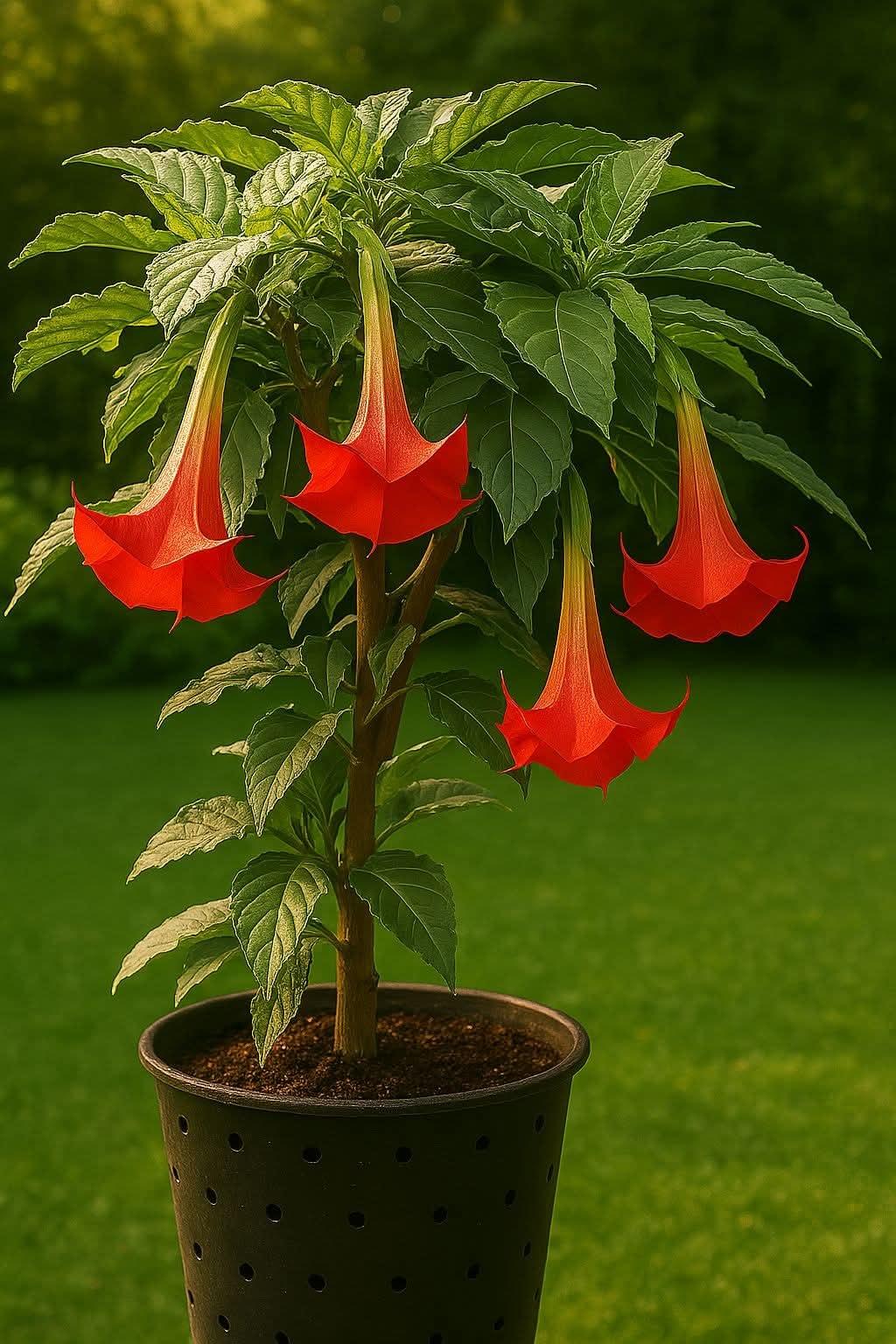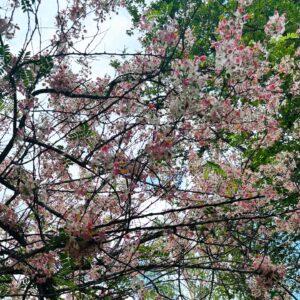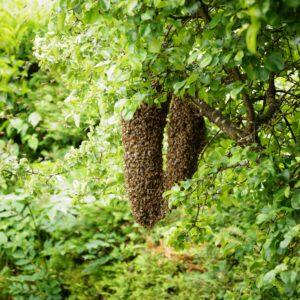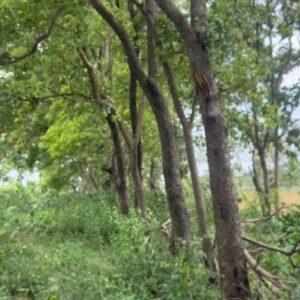The Golden Angel’s Trumpet TreeBrugmansia Yellow.
The beautiful ornamental plant Brugmansia, often called Angel’s Trumpet, is valued for its huge, hanging trumpet-shaped blooms that release a strong, sweet aroma, particularly at night. One of the most eye-catching types is the yellow-flowered one, which brightens up gardens with its sunny, bell-shaped blooms.
Originally from South America, Brugmansia is commonly cultivated in tropical to subtropical regions as a little tree or big bush. It can be overwintered indoors as a container plant in colder climates.
🌿 Summary
Botanical name: Brugmansia suaveolens (Yellow variety)
Common names: Brugmansia Yellow, Yellow Angel’s Trumpet, Angel Trumpet Tree
Plant type: Tropical perennial shrub or tree
Height: 6 to 15 feet (1.8 to 4.5 meters), depending on the weather and trimming
Width: 4 to 8 feet (1.2 to 2.4 meters)
Foliage: Huge, soft green leaves with a somewhat fuzzy feel
Flowers: yellow trumpet-shaped flowers, 6–12 inches in length, that droop downward
Fragrance: Exceedingly sweet, particularly in the late afternoon and at night
Blooming season: Spring through fall (year-round in tropical climes)
💧 Watering Schedule
Although it thrives in constant moisture, Brugmansia Yellow cannot withstand wet ground.
Spring–Summer (the active growing season):
Water thoroughly two or three times a week.
Container plants may require daily watering in extremely hot conditions.
The fall and winter months:
Water only occasionally, such as once a week or when the soil is dry 2 inches deep.
Take care of adequate drainage for your containers. Water well until water flows from the bottom, but avoid letting the pot stay in standing water.
Water stress symptoms include:
Underwatering is when plants wilt throughout the day.
Yellowing lower leaves may indicate inadequate drainage or excessive watering.
Temperature and light requirements ☀️
Sunlight:
Requires full sun to partial shade.
The best bloom production occurs with 6–8 hours of sunshine each day.
Provide light afternoon shade in warm areas.
Temperature:
Flourishes at 20–30°C (68–86°F).
Not able to withstand sub-zero temperatures.
Minimum: 7°C (45°F) – if it falls below this temperature, bring it inside or protect it.
❄️ Cold weather advice: Overwinter indoors in a cool, bright room, and plant in large containers.
🌱 Soil and Fertilizer Requirements
The Soil:
A rich, loamy, well-draining soil is preferred.
Add compost and perlite or sand to the garden soil.
pH: between neutral and moderately acidic (6.0-7.0)
Fertilizer:
Brugmansias consume a lot.
Use a balanced liquid fertilizer, such as 10-10-10 or 15-15-15, every two weeks throughout the growth season.
When the plant is blooming profusely, use a bloom booster fertilizer that is high in phosphorus, such as 15-30-15.
Organic substitutes include fish emulsion, compost tea, and banana peel water.
✂️ Upkeep and Pruning
When to prune: before the start of new development, in late winter or early spring.
Take out:
Crossing, broken, or dead branches.
Remove extra suckers from the base to encourage a tree-like form.
Cut slightly above the Y-shaped branching places to encourage flowering (flowering usually occurs from these joints).
Regular pruning helps the plant maintain its size, bushiness, and productivity.
Methods of Propagation
Stem Cuttings (the most frequent occurrence):
Collect 6–8 inch clippings from branches of semi-hardwood.
Dip in rooting hormone after removing lower leaves.
Put it in water or damp soil; the roots will develop in two to four weeks.
Seeds:
Although seedlings can be cultivated from seeds, blooming may take longer.
In order for seeds to germinate, they must be kept warm and moist.
Plants cultivated from cuttings keep more of their parent’s characteristics than those grown from seeds.
🐛 Problems and Pests
Although generally hardy, Brugmansia can experience:
Aphids
Whiteflies
mites of spiders
Caterpillars
snails and slugs (particularly around the base).
Treat with neem oil spray or insecticidal soap every 10–14 days.
On undersides, regularly check for insects or leaf damage.
Overwatering or insufficient drainage might result in root rot. Make sure the soil is light and the air is circulating.
Beware of Toxins
If eaten, every portion of the Brugmansia plant, including the leaves, flowers, seeds, and stems, is extremely hazardous. It includes hyoscyamine, atropine, scopolamine, and other alkaloids that have an impact on the nervous system.
Keep your distance from kids and animals.
When pruning or handling sap, use gloves.
🎍 Applications for Gardens and Landscapes
Use it as a patio tree, specimen plant, or container centerpiece.
Ideal for evening gardens, tropical borders, and aromatic gardens.
Combines well with elephant ears, palms, and hibiscus for a dramatic effect.
🌸 Bonus: Moths and hummingbirds are drawn to the blooms, particularly at dusk.
The conclusion is that.
The Brugmansia Yellow – Angel’s Trumpet is an unforgettable addition to any garden, producing gorgeous blooms and a strong scent with minimal effort. This tropical beauty will repay you with cascading trumpets every year as long as it receives sunshine, water, and nourishment.”
Brugmansia Yellow – Angel’s Trumpet Tree
₨1,200.00
The beautiful ornamental shrub or little tree known as the Yellow Angel’s Trumpet is called Brugmansia Yellow because of its massive, drooping, trumpet-shaped yellow blooms. It’s indigenous to South America, where it puts on a spectacular show with flowers that emit a sweet, alluring aroma in the evening. The plant flourishes in warm, sunny environments with well-drained soil and consistent watering. Pruning is advantageous for maintaining form and promoting flowering in Brugmansia, which thrives in moderate to direct sunlight. Although aesthetically pleasing, every component of the plant is harmful if eaten and should be handled with caution in front of kids and pets. It’s ideal for giving gardens a romantic, tropical feel.





Reviews
There are no reviews yet.